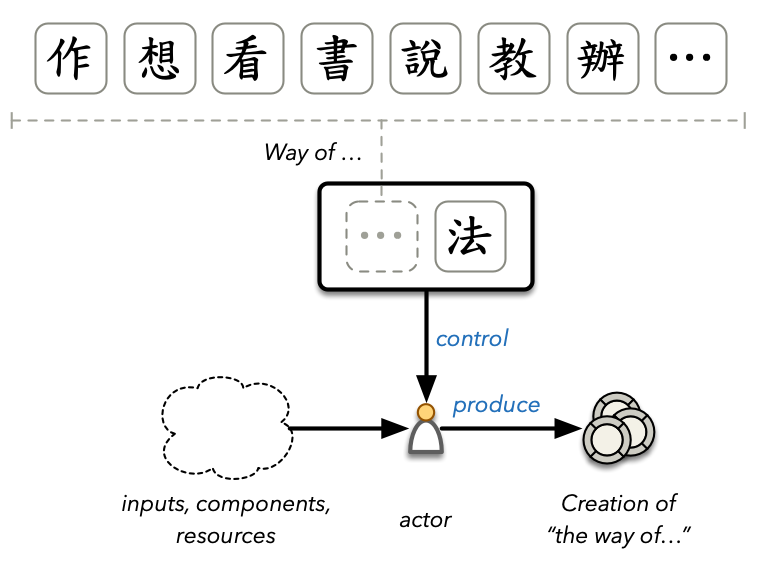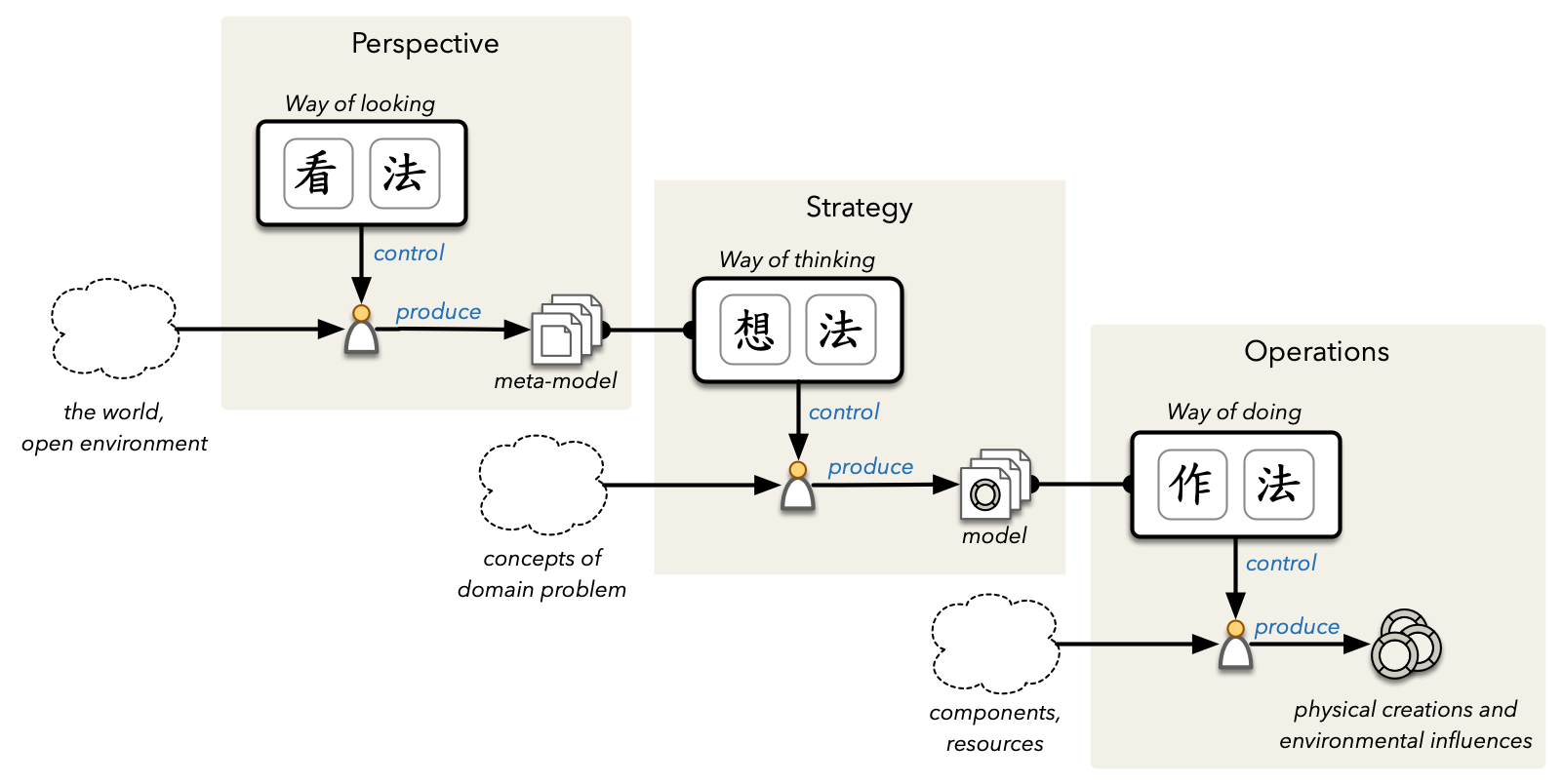Hierarchy of Ways
,Introduction
We do, we speak, we think, we see and we teach. We act. Through acting, we influence the surrounding environment – others, objects, the world, or our inner environment – our own thoughts or words. Our activities follow patterns, methods or ways of doing. Based on our understanding of the problem, the results of our actions are sometimes harmonious with the environment, and sometimes create undesirable or conflicting results.
Additional conflicts arise from the constantly changing environment, with or without our doing. Our ways that reflect the state of the environment from the past might not match the current state of the world. What used to be a good way in a given place or time, might not fit into another. If we persist in our ways and insist on carrying out the actions according to our established historical ways we will sooner or later come into a conflict with a change in the environment.
If the conflict arises from our doing, then how we can approach changes to our ways of doing things? What can help us guide the change? Inspired by a language pattern we try to establish a simple perspective framework to help us recognise complex or chronic problem and identify potential resolution.
Inspiration from the Mandarin Language
We can borrow a pattern from the Mandarin language. There is a character 法 fǎ that has many meanings: law, rule, regulation, norm, standard, model, example, method, way; just to name a few. There is a family of nouns containing this character that are more specific instances of the above mentioned meanings, such as method of doing 作法 zuòfǎ, way of thinking 想法 xiǎngfǎ, perspective or way of looking 看法 kànfǎ, method 辦法 bànfǎ, way of speaking 說法 shuōfǎ, “way of book script” if we stretch it or simply calligraphy 書法 shūfǎ. The English equivalent of the character-word pattern might be a short word phrase that starts with “method of …” or “way of ….” For simplicity of this text, we will be using “way of…,” but we will keep in mind all the potential nuances of the meaning.
The pattern of the words containing the common character 法 fǎ makes the “way of …” explicit and obvious. They describe activities or processes that are carried out according to a template, pattern or a model. The type of the activity is given by the first character. Moreover the pattern establishes some kind of potential explicit relationship between the words, that we will have a look at later in this text.
We might argue that in In English or in other Indo-European languages we might use the similar concept by just using the word “way of ….” Although by using it we might either require more descriptive specification of the modified activity or it might be not part of common speech. In either way we would lose the immediate and explicit connection between the “Way of …” words which is what we would like to investigate a bit more.
Let us consider the Systems theory. Now we look at the 法 fǎ pattern from the Systems theory perspective: The way of is a regulator of an actor to process the inputs, components, resources into a result that has been influenced by the method, model, template or a pattern.

Doing, thinking, looking
From all the potential words in the pattern we are going to have a look at three particularly interesting combinations of the way. They are the verbs or activities to do, to think and to look.
To do is 作 zuò which gives us 作法 zuòfǎ which means method of doing something, modus operandi. It might be a food preparation method, material processing or a product creation.
To think is 想 xiǎng which gives us 想法 xiǎngfǎ which means way of thinking or opinion. Might reflect one’s attitude towards socio-political arrangement, engineering methodology (or even non-existence of such), opinion about rights and priorities.
To look is 看 kàn which gives us 看法 kànfǎ which means way of looking at things or perspective. It is about our perception of the world. A bit extreme examples would be distinctions whether the systems of the world are all mechanical or not, whether a systems of the world can be described as stateful or stateless.
Ways as a System
From Systems theory perspective, if we look at the 法 fǎ pattern as a regulator, what does it regulate? What is the result of the system? Which context is the system being used in?
Zuòfǎ 作法
作法 zuòfǎ – way of doing – regulates production, immediate operations, tactical matters. There is a direct linear-casual relationship between the agent carrying out the instructions of the method and the environment. The 作法 zuòfǎ results in immediate and concrete actions that influence the environment directly. It answers a question “How to reach a recognised goal?”
We follow a process; a manufacturing process, gardening, a cooking process, a civil engineering process or software development process. The process creates a product such as a delicious meal, a computer application, a building or it might modify a social or an ecological environment.
Xiǎngfǎ 想法
想法 xiǎngfǎ – way of thinking – regulates strategy that leads to the design of 作法 zuòfǎ – the method of concrete creation. The relationship between the “thinker” or designer of the creation process and the environment is indirect. In between is 作法 zuòfǎ – the method of production itself that is being developed. 想法 xiǎngfǎ answers the question “How to create a system that delivers expected output?”
Kànfǎ 看法
看法 kànfǎ – way of looking – regulates the creation of guidelines or models how to design models. It regulates production of a meta-model. It is about perception of the world and the how the world operates. This might be influenced by traditions, culture or the degree to which we are open-minded, all within the context of the problems being solved: team, organisation, social group, geographic region or similar.
Relationship
In between the above mentioned three Ways of… we can establish a relationship and put them in an order of mutual hierarchical influence:
$$ \overset{\text{kànfǎ}} {\underset{\text{perspective}}{\text{看法}}} \xrightarrow{\text{influences}} \overset{\text{xiǎngfǎ}} {\underset{\text{way of thinking}}{\text{想法}}} \xrightarrow{\text{influences}} \overset{\text{zuòfǎ}} {\underset{\text{way of doing}}{\text{作法}}} \xrightarrow{\text{influences}} \text{output} $$
This hierarchy of influence says that way of looking at things influences how we think, how we think influences our ways of doing. At the end, the way of doing influences the end result – how we interact with the environment and how we change it at the end.

From System’s theory view, the ways are a chain of production processes where one production is regulated by the product of a higher level of the hierarchy. We influence our environment through the process of the 作法 zuòfǎ – way of doing. This process is regulated by the output of 想法 xiǎngfǎ – way of thinking. The way how we think is then regulated by the 看法 kànfǎ – way of looking.
Problem Recognition and Resolution
Bottom-up traversal of the hierarchy – from the environment to our perception of the world – has an application for problem recognition and resolution. If we are having conflicts at a certain level we can navigate the hierarchy of influence upwards and try to solve problem at a higher level. Making a change at a higher level might solve a problem at the lower level. In a better scenario, it might even eliminate the existence of the source of the problem to be solved at the lower level, therefore preventing the problem altogether.
If the product we are producing or the interaction with the environment we are having is causing problems, we change our 作法 zuòfǎ to try to fix the problem. Changing 作法 zuòfǎ might mean optimising the process, changing the type or quantities of ingredients, restructuring the production procedure or similar activity. The change directly influences the production or the interaction with the environment.
One might reach a point where no matter how much they pay attention to the process or how we adjust the process, we might still not be getting satisfying results. One might be dealing with a chronic problem. In that case, one needs to change the production process – change our 作法 zuòfǎ through 想法 xiǎngfǎ – our way of thinking. By changing 想法 xiǎngfǎ we open the possibility to generate new processes, methods, patterns of production or environmental influence that we might try to resolve our problem. As an example it might be using different engineering techniques.
In a similar path of chronic dissatisfaction we might find ourselves in a situation where no matter how we change our way of thinking, the methods of production that we design still yield problematic results or undesirable side effects. The problem is in 看法 kànfǎ, in our perspective. When all the 想法 xiǎngfǎ we tried are not satisfactory, we need to change or adjust our 看法 kànfǎ – perception of the world.
To develop particular 看法 kànfǎ the thinker has to take a step back from cultural, political, customary traditions. The thinker has to identify themselves with the environment by looking at it and perceiving it as it is without imposing their concepts and thoughts on it. Only then, by exploring with different perspectives on the world we create the possibility for new 想法 xiǎngfǎ to arise and as a consequence into new and diverse 作法 zuòfǎ that influence the production output or the interaction with the world.
Summary
“Influence Hierarchy of Ways” is a simple conceptual framework to aid in problem solving and decision making. It is useful when we have exhausted our options and still see no improvements in our doing, or when another method of doing does not yield significant improvement to the situation, or even worse – if we end up running in circles. In such cases, being aware of The Ways we can follow the hierarchy upwards, investigate and make adjustments at that level.
In the end, it is the perspective which influences how we think and how we do things. When doing things differently was not good enough, neither thinking differently, then there is the option to explore different ways of looking at the world that is available to us.
Comments powered by Talkyard.